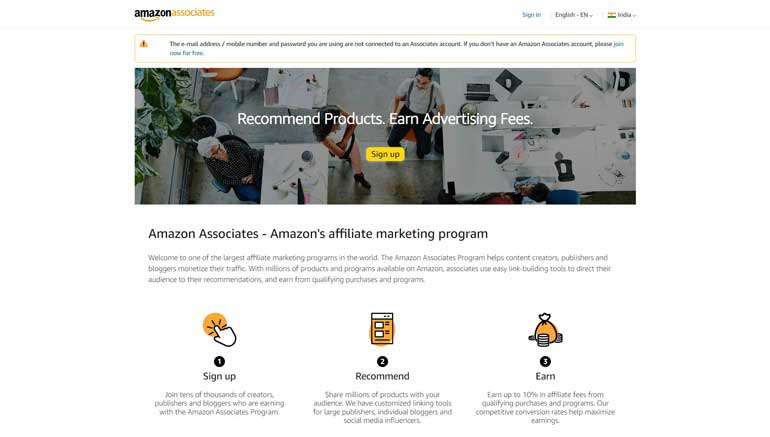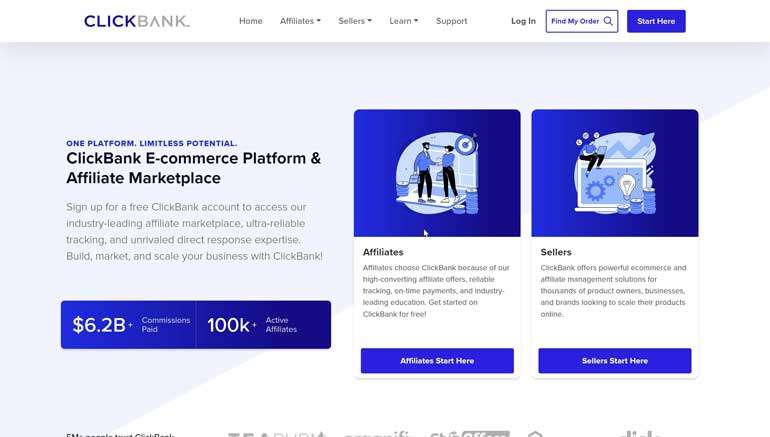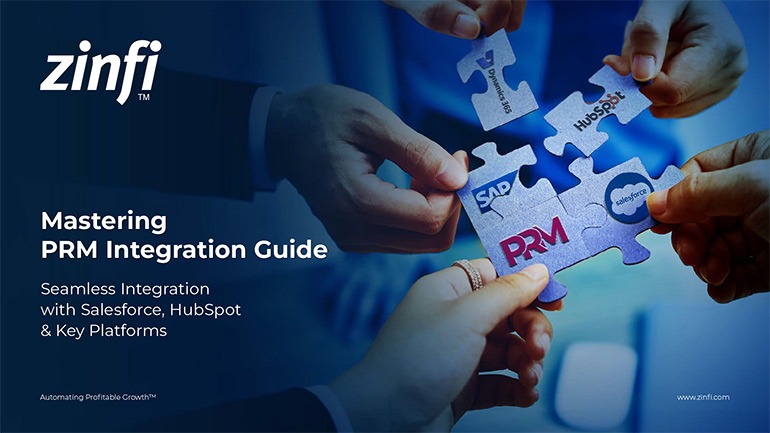Best Practices Articles

Mastering Affiliate Marketing: A Comprehensive Guide to Earning, Promoting, and Excelling
Table of Contents
- What is affiliate marketing, and how does it work?
- What are the best affiliate marketing programs to join?
- How do I choose the right affiliate products to promote?
- What are the most effective ways to promote affiliate links?
- How much money can I make through affiliate marketing?
- What are the biggest challenges of affiliate marketing?
- How do I track my affiliate marketing performance and earnings?
- Can I do affiliate marketing without a website or blog?
- What are the legal and ethical considerations of affiliate marketing?
- How do I get started in affiliate marketing?
Welcome to the dynamic world of affiliate marketing, the strategic terrain where savvy marketers and influential content creators converge to generate revenue through performance-based promotions. In this comprehensive guide, we delve into the multifaceted aspects of affiliate marketing, answering pivotal questions that can transform novices into seasoned affiliates. Whether you’re grappling with the basics of how affiliate marketing functions, searching for the best programs to join, or seeking the most effective methods to promote affiliate links, this article is your beacon in the often-opaque waters of affiliate marketing.
We’ll explore the potential earnings for those who master the art of promotion, the challenges even the most experienced marketers face, and the strategies to overcome them. For those who are curious about tracking performance, say, or are wondering if it’s possible to venture into this domain without a website, we provide advice that achieves results and helps you remain aligned with the industry’s legal and ethical standards. From initiating your first steps into affiliate marketing to scaling your efforts for maximum profit, this guide is tailored to provide actionable knowledge. If you’re looking to supplement your income or perhaps build a full-fledged business, read on to unlock the secrets of affiliate marketing success.

Download the best practices guidebook
1. What is affiliate marketing, and how does it work?
Affiliate marketing is a performance-based marketing strategy where a business rewards one or more affiliates for each visitor or customer brought by the affiliate’s marketing efforts. It works by spreading the responsibilities of product marketing and creation across multiple parties. It manages to leverage the diverse talents of various individuals for a more effective marketing strategy while providing contributors with a share of the profit.

To make this work, three different parties must be involved:
- Seller and product creators: The seller, whether a solo entrepreneur or large enterprise, is a vendor, merchant, product creator, or retailer with a product to market. The product can be a physical object, like household goods, or a service, like makeup tutorials.
- The affiliate or advertiser: Also known as a publisher, the affiliate can be either an individual or a company that markets the seller’s product in an appealing way to potential consumers. In other words, the affiliate promotes the product to persuade consumers that it is valuable or beneficial and convince them to purchase it. If the consumer buys the product, the affiliate receives a portion of the revenue.
- The consumer: Whether the consumer knows it or not, they (and their purchases) drive affiliate marketing. Affiliates share these products with them on social media, blogs, and websites.
When consumers buy the product, the seller and the affiliate share the profits. Sometimes, the affiliate will be upfront with the consumer by disclosing that they receive a commission for their sales. Other times, the consumer may not be aware of the affiliate marketing infrastructure behind their purchase.
The affiliate may get paid in various ways:
- Pay per sale: This is the standard affiliate marketing structure. In this program, the merchant pays the affiliate a percentage of the product’s sale price after the consumer purchases the product because of the affiliate’s marketing strategies.
- Pay per lead: A more complex system, pay-per-lead affiliate programs compensate the affiliate based on the conversion of leads. The affiliate must persuade the consumer to visit the merchant’s website and complete the desired action — filling out a contact form, signing up for a product trial, subscribing to a newsletter, or downloading software or files.
- Pay-per-click: This program incentivizes the affiliate to redirect consumers from their marketing platform to the merchant’s website. This means the affiliate must engage the consumer to the extent that they will move from the affiliate’s site to the merchants’ site. The affiliate is paid based on the increase in web traffic.
2. What are the best affiliate marketing programs to join?
When considering the best affiliate marketing programs to join, it is crucial to evaluate several factors that align with your goals, audience, and content strategy. As of my last update, here are some expanded details on notable programs:
- Amazon Associates: With an extensive range of products, Amazon Associates stands out for its universal appeal. Affiliates benefit from Amazon’s high conversion rates and many items to promote. The user-friendly program is an excellent choice for beginners and seasoned marketers. The commission structure varies by product category, but the sheer volume of potential sales can compensate for the lower percentage in some categories.
- ClickBank: Specializing in digital products, ClickBank is a favorite for affiliates promoting e-books, courses, and software. They offer some of the highest commission rates in the industry, sometimes up to 70% or more. Their marketplace is diverse, with products covering numerous niches, which makes it easier for affiliates to find offerings that resonate with their specific audience.
- Commission Junction (CJ): This platform is known for its vast network of advertisers, which provides affiliates with many options. CJ Affiliate is an excellent choice for those looking to promote big brands and is known for its reliable payment system. The platform also offers robust tracking and reporting features essential for monitoring performance and optimizing campaigns.
- ShareASale: With two decades in the affiliate marketing industry, ShareASale is revered for its reliability and diverse marketplace. Affiliates can access various products and services, from fashion to software to green products. The platform is known for its straightforward user interface and timely payouts.
- Rakuten Advertising: This affiliate network is praised for its advanced technology and quality advertiser base. While their product range may not be as extensive as some other networks, they often partner with high-end brands, which can be attractive for affiliates targeting a more affluent audience.





In addition to these, some niche-specific programs and networks cater to specific markets, such as:
- Bluehost: A web hosting company that offers a lucrative affiliate program for those in the tech and blogging space.
- Market Health: Ideal for those in the health and beauty sectors, offering a wide range of products with competitive commissions.
- Many more: Multiple types of products targeting business-to-business and business-to-consumers offer affiliate programs.


Selecting an affiliate program is about more than just the potential earnings. Consider the support and training provided by the program, the user experience of their platform, the ease of use, and the transparency of their operations. The best affiliate marketing programs are those that not only offer competitive commissions but also align with your audience’s interests and needs, provide excellent customer service, and maintain a reputation for quality and reliability.
3. How do I choose the right affiliate products to promote?
Choosing the right affiliate products is critical in your affiliate marketing journey. Here’s a more detailed approach to making that choice:
- Relevance: The cornerstone of effective affiliate marketing is relevance. The products you promote should feel like a natural extension of your content. For instance, promoting health supplements or workout gear would be a harmonious choice if you run a fitness blog. Your audience visits your platform for specific content, and the products you endorse should complement that content.
- Quality and value: Promoting products you have vetted for quality is essential. Your audience’s trust is paramount, and you risk losing credibility if you promote subpar products. Moreover, consider the value proposition of the products. Do they offer a solution to a problem? Are they innovating in their space? Products that deliver clear value convert better over the long run.
- Demand and market saturation: Conduct market research to understand the demand for the products you want to promote. Use tools like Google Trends, keyword research, and social media listening to gauge interest. However, you should also be wary of market saturation. If too many affiliates promote the same product, it may be challenging to carve out a niche for yourself.
- Commission structure: Higher commission rates are attractive, but not the only factor. Consider the price point of the product, the conversion rate, and the lifetime value of the customers you’re referring to. Sometimes, a lower commission rate on a high-ticket item can be more lucrative than a higher rate on a low-cost product.
- Merchant reputation and support: The reputation of the merchant is crucial. A merchant with a history of reliable payouts, fair affiliate policies, and strong support for affiliates is more likely to contribute to your success. Look for merchants who provide affiliates with resources such as creatives, product samples, and promotional strategies.
- Terms and conditions: Be sure to read the fine print. Some affiliate programs have strict rules about where and how you can promote their products. Ensure that these terms align with your marketing practices and ethical standards.
- Tracking and analytics: Look for affiliate programs that offer robust monitoring and analytics tools. Having data that reveals which products are selling and which strategies are working will help refine your approach and increase your earnings.
Take a strategic approach to product selection. If you focus on relevance, quality, demand, commission structure, merchant reputation, and the terms of the program, you are more likely to find products that not only align with your brand but also have the potential to generate significant revenue.
4. What are the most effective ways to promote affiliate links?
Promoting affiliate links effectively is crucial to the success of an affiliate marketing strategy. Here are some of the most effective ways to promote affiliate links and ensure each method aligns with the best SEO practices:

- Content marketing: Creating high-quality, valuable content is at the heart of successful affiliate marketing. Blog posts, articles, and guides that help solve problems or answer questions can naturally incorporate affiliate links. For instance, a detailed product review with an embedded affiliate link is a good way to drive purchases. SEO plays a vital role here, as well-targeted keywords help your content rank higher on search engines, increasing visibility.
- Email marketing: Building an email list lets you send targeted promotions to a warm audience. You can encourage clicks and conversions by providing consistent value in your emails and integrating affiliate links organically. Segmenting your list and personalizing content can significantly increase the effectiveness of your campaigns.
- Social media marketing: Platforms like Instagram, Facebook, and Pinterest can be powerful tools for affiliate marketing. You can use engaging posts, stories, and social media ads to promote products. Influencers often leverage their following to promote affiliate products through these channels.
- SEO for organic search: Optimizing your website for search engines is a long-term strategy that can bring in more consistent traffic. We recommend you use keyword research to find what your audience is searching for and create content to match those queries to attract visitors who are already interested in the products you are promoting.
- Paid advertising: PPC campaigns can drive targeted traffic to your affiliate products, whether through Google Ads or social media advertising. By carefully selecting keywords and crafting compelling ad copy, you can promote your affiliate links to a highly interested audience.
- Video marketing: Platforms like YouTube offer a vast audience for affiliate marketers. Creating informative and entertaining videos featuring products and affiliate links in the description can tap into visual and auditory audiences.
- Webinars and live demos: Hosting webinars or live product demos can be an engaging way to showcase the benefits of a product. If you provide an in-depth look at the product and answer questions in real-time, you can build trust and encourage viewers to use your affiliate links to make a purchase.
Each of these methods requires a strategic approach to SEO that ensures content is discoverable, engaging, and provides value to the audience. By combining these tactics and consistently analyzing and refining your strategy based on performance data, you can maximize the effectiveness of your affiliate link promotion.
5. How much money can I make through affiliate marketing?
The potential earnings from affiliate marketing can vary widely. It depends on a multitude of factors, including the niche, the effectiveness of the promotional strategy, the affiliate’s marketing skills, and the amount of time invested. Here are some considerations:

- Niche selection: Some niches are more lucrative than others due to higher product prices or commission rates. For example, technology and finance often offer higher commissions than common consumer goods.
- Commission structures: Different affiliate programs offer different commission structures. Some may provide a high percentage of sales, while others offer lower rates but have higher-priced products or recurring commissions for subscription services.
- Traffic volume: The amount of traffic you can drive to your affiliate links directly impacts your potential earnings. High traffic volumes can lead to more conversions, primarily if the traffic is targeted and consists of individuals with a high intent to purchase.
- Conversion rates: Not all traffic is equal. The key is to attract qualified traffic that is likely to convert. In addition to the quality of your content, the alignment between the product and your audience, and the persuasiveness of your promotional tactics all influence conversion rates.
- Promotional strategies: Effective promotion, as mentioned earlier, is essential. Affiliates skilled in SEO, content marketing, email marketing, and other promotional strategies tend to earn more because they can consistently reach and engage their audience more effectively.
- Time investment: Affiliate marketing can be a side hustle or a full-time job. Those who can invest more time in learning, testing, and refining their strategies often see better results.
- Long-term efforts: Affiliate marketing is often not a get-rich-quick scheme. It requires building a presence, trust with your audience, and a portfolio of affiliate products. Long-term efforts in creating valuable content and establishing a brand provide the best path to earning substantial passive income over time.
Realistically, affiliates can earn anywhere from a few hundred to several thousand dollars per month, with top affiliates earning six-figure or even seven-figure incomes annually. However, it’s essential to set realistic expectations and understand that success in affiliate marketing typically requires time, effort, and a strategic approach.
6. What are the biggest challenges of affiliate marketing?
Affiliate marketing, while lucrative for many, comes with challenges. Addressing these challenges effectively is crucial in building a successful affiliate marketing business:
- Competition: One of the most significant challenges in affiliate marketing is the high level of competition. When many affiliates are promoting the same products or services, it can be difficult to stand out. To overcome this, you must develop unique selling propositions and leverage SEO to target less competitive keywords or niches.
- Building trust: Consumers are becoming more discerning about the content they consume and the products they purchase. Affiliates must work hard to build and maintain trust with their audience. This means affiliates should promote only products that they truly believe in and always be transparent about the nature of affiliate links.
- Changes in affiliate terms and conditions: Merchants can change their affiliate program terms, commission structures, or promotional policies with little notice. These changes can significantly impact an affiliate’s earnings. Staying adaptable and diversifying your efforts among multiple affiliate partnerships can mitigate this risk.
- SEO challenges: It can be difficult to keep up with the ever-changing algorithms of search engines. Affiliates must continuously educate themselves on SEO best practices and update their content to maintain visibility.
- Dependency on third-party platforms: Whether they are dealing with changes to Google’s search algorithm, social media platforms altering their feed algorithms, or email service providers updating their policies, affiliates are often at the mercy of third-party platforms that can change the rules of engagement at any time.
- Scaling the business: For affiliate marketers, scaling effectively can be one of the most difficult challenges to overcome. It’s crucial to find a balance between expanding your reach and maintaining the quality and authenticity of your content. Scaling often requires additional investment in tools and resources, and sometimes even a team to manage increased workloads.
- Regulatory compliance: Affiliates must comply with legal requirements, such as disclosing affiliate relationships and adhering to privacy laws. Failure to comply can result in penalties and damage to reputation.
- Market saturation: Some niches become saturated with affiliates, making it hard to achieve visibility. Finding untapped markets or creating a unique angle on popular topics can help overcome this challenge.
- Product discontinuation: Sometimes, a product you’ve successfully promoted may be discontinued, affecting your income stream. Diversifying the products you promote can help ensure stability.
Affiliate marketers who can navigate these challenges with strategic planning, continuous learning, and adaptability are the most likely to achieve long-term success in the industry.
7. How do I track my affiliate marketing performance and earnings?
Tracking your affiliate marketing performance and earnings is critical to understanding the reasons behind your successes and failures and optimizing your strategy. Here are some methods and tools you can use:

- Affiliate dashboard: Most affiliate programs provide a dashboard to track your sales, clicks, and earnings. These dashboards typically offer reports that break down your performance by date, product, and other metrics.
- Analytics tools: Utilize tools like Google Analytics to track how users interact with your website and affiliate links. Setting goals and hosting events can also help you understand the user journey and identify where you lose potential conversions.
- UTM parameters: Add UTM parameters to your affiliate links to track their performance in detail. UTM parameters can tell you which sources, mediums, and campaigns are driving the most traffic and conversions.
- Conversion pixels: Some affiliate programs allow you to place a conversion pixel on your “thank you” or confirmation page. Conversion pixels can track when a sale is made and attribute it back to your affiliate link.
- A/B testing: Conduct A/B testing on your content, calls to action, and the placement of affiliate links to determine what strategies yield the best results.
- Affiliate software: Various affiliate marketing software solutions offer advanced tracking and reporting features. These solutions can help you manage multiple affiliate programs more efficiently and track performance with a single tool.
- Spreadsheets: We recommend you keep a spreadsheet to record and monitor your affiliate links, the dates of promotions, and the earnings from each association. This can help you identify trends and evaluate performance over time.
By regularly monitoring and analyzing your affiliate marketing performance, you can make data-driven decisions to improve your strategy and increase your earnings.
8. Can I do affiliate marketing without a website or blog?
Affiliate marketing without a website or blog is entirely feasible. Many successful affiliate marketers have utilized alternative methods to promote their affiliate links. Here are some strategies that can be employed:
- Social media platforms: Social media is a powerful tool for affiliate marketers. Platforms like Instagram, Facebook, X (formerly Twitter), and Pinterest can be used to build a following and engage with an audience. Creating valuable content and integrating affiliate links can direct your followers to products or services. However, it’s essential to follow each platform’s promotional content regulations and maintain transparency with your audience.
- Video content: YouTube is the second largest search engine and a prime affiliate marketing platform. You can create product reviews, tutorials, and informative content where affiliate links can be included in the video description. Consistency and quality content are vital to growing a subscriber base and increasing the visibility of your affiliate links.
- Email marketing: Building an email list provides you with an opportunity to send targeted campaigns with affiliate links. The key to successful email marketing is to provide value beyond just selling products. Educational content, insights, and personal stories can create a connection with your audience, making them more likely to consider your recommendations.
- Online courses and ebooks: If you have expertise in a particular area, creating an online course or ebook can be a lucrative way to incorporate affiliate marketing. You can recommend products or services within your content that enhance the learning experience for your audience.
- Podcasting: Another avenue for affiliate marketing is to start a podcast. You can mention products or services during your episodes and include affiliate links in your show notes.
- Paid advertising: Utilizing paid advertising on platforms like Google Ads, Facebook Ads, or even native advertising networks can drive traffic to your affiliate offers. This method requires an investment but can yield quick results if done correctly.
- Content publishing platforms: Some successful affiliate marketers write articles on platforms like Medium or LinkedIn to attract readers interested in their niche. You can weave affiliate links into your written content, provided that such links add value and are relevant to the topic.
- Mobile apps: If you have the resources to develop a mobile app, it can be a powerful platform for promoting affiliate products. Apps that offer unique content and features are the most likely to attract a dedicated user base.
- Webinars: Hosting webinars on topics related to your affiliate products can effectively educate and sell to an audience. If you provide valuable information and demonstrate how a product works, you can encourage participants to purchase through your affiliate links.
Each of these methods requires a strategic approach and an understanding of the platform you choose to use. The key to success with all of these methods is to build trust with your audience by providing value and being transparent about your affiliate relationships.
9. What are the legal and ethical considerations of affiliate marketing?
When engaging in affiliate marketing, it’s essential to consider both the legal and the ethical aspects of your activities to maintain a trustworthy relationship with your audience and comply with regulations:
- Full disclosure: The FTC mandates that affiliate marketers disclose their relationships with the companies they promote. This means you must clearly state that you may receive a commission if someone purchases through your affiliate link. These disclosures should be conspicuous rather than hidden.
- Honest reviews and endorsements: As an affiliate marketer, you must be honest in your reviews and endorsements. Misleading your audience with false claims can lead to legal issues and damage your credibility.
- Compliance with laws and regulations: Different countries have different laws regarding affiliate marketing. For instance, the General Data Protection Regulation (GDPR) in the EU affects how you collect and use personal data. In the US, the CAN-SPAM Act sets rules for commercial email.
- Respect for intellectual property: Use images, videos, and content legally. Ensure you have the right to use the promotional materials provided by affiliate programs or that you have created or licensed them yourself.
- Avoiding “cookie stuffing”: Some unscrupulous affiliates use “cookie stuffing” to force cookies onto users’ computers without their knowledge, which is illegal and unethical.
- Transparent advertising: If you’re using paid advertising to promote affiliate products, you must be transparent about it. Platforms like Facebook require you to disclose when content is a paid promotion.
- Data privacy: With increasing concern over data privacy, handling any data you collect responsibly and in line with privacy laws is essential.
- No spamming: Whether email marketing, social media, or any other platform, spamming potential customers with affiliate links is both illegal and ineffectual.
- Regular monitoring of affiliate terms: Affiliate programs can change their terms and conditions, so be sure to stay updated and comply with new requirements.
By adhering to these legal and ethical guidelines, you can build a sustainable affiliate marketing business based on trust and transparency.
Read more on fraud prevention in affiliate marketing.
10. How do I get started in affiliate marketing?
Starting in affiliate marketing can be a rewarding venture if approached with diligence and strategy. Here’s a step-by-step guide to getting started:
- Choose your niche: Select a niche that you are passionate about and has a viable market. Your niche should be specific enough to target a particular audience but broad enough to have a variety of products and services you can promote.
- Research and join affiliate programs: Look for reputable affiliate programs with a good track record of paying their affiliates and offering support. Consider the commission structure, the quality of the products, and the reliability of the tracking system.
- Understand your audience: Knowing your audience is crucial. Perform research to understand their needs, preferences, and problems so you can offer solutions through the products you promote.
- Create valuable content: Whether you reach your audience through a blog, social media, or YouTube, create content that adds value to that specific audience, whether that means providing reviews, tutorials, or informative articles.
- Drive traffic to your content: Use proven SEO techniques to drive organic traffic. You can also use paid ads, social media, or email marketing to get more eyes on your affiliate links.
- Build an email list: An email list allows you to communicate directly with your audience. To be successful over the long term, you must provide value via your newsletters and integrate your affiliate links strategically.
- Track your results: Use analytics to track your traffic, clicks, and conversions. This data will help you understand what’s working and what’s not, allowing you to make informed decisions.
- Optimize and scale: Optimize your content and strategy as you gather data. Test different approaches to determine the best results, and then scale your efforts accordingly.
- Stay updated: Affiliate marketing is a constantly changing field. Stay up to date with the latest trends, tools, and strategies to make sure your affiliate marketing efforts remain effective.
- Comply with legal requirements: Always be transparent with your audience about your affiliate relationships and comply with all legal requirements.
Starting with these foundational steps, you can grow your affiliate marketing business over time, creating a sustainable source of income.

Conclusion
Embarking on the affiliate marketing journey is akin to setting sail on a vast ocean of opportunity. We’ve navigated through the essential questions that shape the foundation and growth of a successful affiliate marketing venture. From identifying the best programs to align with to choosing the right products and promoting them through the most effective channels, we’ve covered a broad range of strategies to ensure you’re equipped with the knowledge you need to thrive.
While the potential earnings in affiliate marketing are as varied as the strategies employed, remember that success is ultimately a product of persistence, innovation, and ethical marketing practices. Certainly, challenges are part of the journey, but they’re also milestones waiting to be conquered. With the right tools to track your performance and a clear understanding of the legal issues involved, you can build a venture that stands the test of time and thrives amid fluctuating market trends.
Whether you have a website or not, the doors to affiliate marketing are open. It’s a field that rewards those willing to learn and adapt. We hope this guide serves as a valuable resource as you proceed on your path to affiliate marketing mastery. The journey may be long, but the rewards can be substantial. Here’s to your success in affiliate marketing—may your efforts be fruitful and your growth exponential.
For more information, please check this article.


Best Practices Guidebook
 The Evolution of PartnerOps: Past, Present & Future Best Practices
The Evolution of PartnerOps: Past, Present & Future Best PracticesDownload Guide
 Mastering Channel Sales: Strategies, Best Practices, and Growth Tactics for 2025
Mastering Channel Sales: Strategies, Best Practices, and Growth Tactics for 2025Download Guide
 Winning with Partner Advisory Councils: Best Practices for Partner Engagement & Growth
Winning with Partner Advisory Councils: Best Practices for Partner Engagement & GrowthDownload Guide
 The Future of Partner Ecosystems Best Practices
The Future of Partner Ecosystems Best PracticesDownload Guide
 The AI Revolution: How Technology and Talent are Shaping the Future
The AI Revolution: How Technology and Talent are Shaping the FutureDownload Guide
 Top 105 Partner Management Metrics that Matter Best Practices
Top 105 Partner Management Metrics that Matter Best PracticesDownload Guide
 Mastering PRM Integration Best Practices
Mastering PRM Integration Best PracticesDownload Guide
 Building a Sales Partner Portal with Salesforce Best Practices
Building a Sales Partner Portal with Salesforce Best PracticesDownload Guide
 Building and Managing Partner Ecosystems Best Practices
Building and Managing Partner Ecosystems Best PracticesDownload Guide
 Mastering Co-Marketing and Co-Selling Best Practices
Mastering Co-Marketing and Co-Selling Best PracticesDownload Guide
 Transforming Partner Ecosystems Best Practices
Transforming Partner Ecosystems Best PracticesDownload Guide
 Mastering Partner Ecosystems Best Practices
Mastering Partner Ecosystems Best PracticesDownload Guide
 Mastering Partner Onboarding Best Practices
Mastering Partner Onboarding Best PracticesDownload Guide
 Partner Ecosystem Management Best Practices
Partner Ecosystem Management Best PracticesDownload Guide
 B2B Marketing in the Age of Intelligence Best Practices
B2B Marketing in the Age of Intelligence Best PracticesDownload Guide
 Multi-Partner Co-Selling Best Practices
Multi-Partner Co-Selling Best PracticesDownload Guide
 A Guide to Enhance Channel Sales Efficiency
A Guide to Enhance Channel Sales EfficiencyDownload Guide
 Mastering Affiliate Marketing Best Practices
Mastering Affiliate Marketing Best PracticesDownload Guide
All Guidebooks







